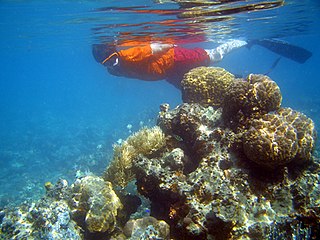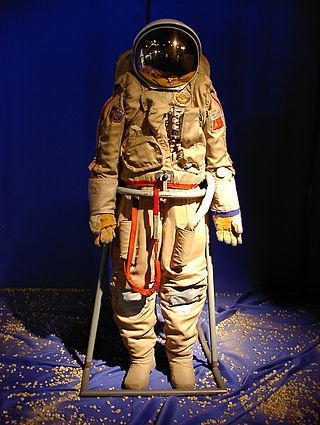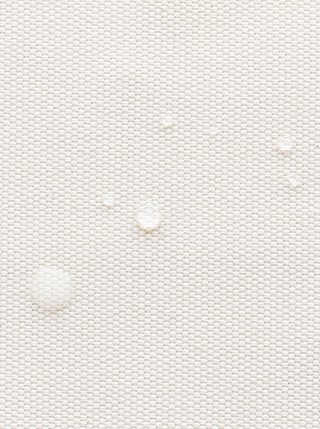
Snorkeling is the practice of swimming face down on or through a body of water while breathing the ambient air through a shaped tube called a snorkel, usually with swimming goggles or a diving mask, and swimfins. In cooler waters, a wetsuit may also be worn. The snorkel may be an independent item or integrated with the mask. The use of this equipment allows the snorkeler to observe the underwater environment for extended periods with relatively little effort, and to breathe while face-down at the surface.
A suit is a set of garments with matching pieces, typically a jacket and trousers.

Hypothermia is defined as a body core temperature below 35.0 °C (95.0 °F) in humans. Symptoms depend on the temperature. In mild hypothermia, there is shivering and mental confusion. In moderate hypothermia, shivering stops and confusion increases. In severe hypothermia, there may be hallucinations and paradoxical undressing, in which a person removes their clothing, as well as an increased risk of the heart stopping.

A wetsuit is a garment worn to provide thermal protection while wet. It is usually made of foamed neoprene, and is worn by surfers, divers, windsurfers, canoeists, and others engaged in water sports and other activities in or on water. Its purpose is to provide thermal insulation and protection from abrasion, ultraviolet exposure, and stings from marine organisms. It also contributes extra buoyancy. The insulation properties of neoprene foam depend mainly on bubbles of gas enclosed within the material, which reduce its ability to conduct heat. The bubbles also give the wetsuit a low density, providing buoyancy in water.

A swimsuit is an item of clothing designed to be worn by people engaging in a water-based activity or water sports, such as swimming, diving and surfing, or sun-orientated activities, such as sun bathing. Different types may be worn by men, women, and children. A swimsuit can be described by various names, some of which are used only in particular locations or for particular types of suit, including swimwear, bathing suit, bathing attire, swimming costume, bathing costume, swimming suit, swimmers, swimming togs, bathers, cossie, or swimming trunks, besides others.

Ice diving is a type of penetration diving where the dive takes place under ice. Because diving under ice places the diver in an overhead environment typically with only a single entry/exit point, it requires special procedures and equipment. Ice diving is done for purposes of recreation, scientific research, public safety and other professional or commercial reasons.

A dry suit or drysuit provides the wearer with environmental protection by way of thermal insulation and exclusion of water, and is worn by divers, boaters, water sports enthusiasts, and others who work or play in or near cold or contaminated water. A dry suit normally protects the whole body except the head, hands, and possibly the feet. In hazmat configurations, however, all of these are covered as well.

A diving suit is a garment or device designed to protect a diver from the underwater environment. A diving suit may also incorporate a breathing gas supply, but in most cases the term applies only to the environmental protective covering worn by the diver. The breathing gas supply is usually referred to separately. There is no generic term for the combination of suit and breathing apparatus alone. It is generally referred to as diving equipment or dive gear along with any other equipment necessary for the dive.

An environmental suit is a suit designed specifically for a particular environment, usually one otherwise hostile to humans. An environment suit is typically a one-piece garment, and many types also feature a helmet or other covering for the head. Where the surrounding environment is especially dangerous the suit is completely sealed.

Waterproof fabrics are fabrics that are, inherently, or have been treated to become, resistant to penetration by water and wetting. The term "waterproof" refers to conformance to a governing specification and specific conditions of a laboratory test method. They are usually natural or synthetic fabrics that are laminated or coated with a waterproofing material such as wax, rubber, polyvinyl chloride (PVC), polyurethane (PU), silicone elastomer, or fluoropolymers. Treatment could be either of the fabric during manufacture or of completed products after manufacture, for instance by a waterproofing spray. Examples include the rubberized fabric used in Mackintosh jackets, sauna suits, and inflatable boats.

Sportswear or activewear is athletic clothing, including footwear, worn for sports activity or physical exercise. Sport-specific clothing is worn for most sports and physical exercise, for practical, comfort or safety reasons.

A tuilik is an Inuit watertight jacket, used when paddling a kayak. It is sealed at the face, at the wrists and around the cockpit coaming. In this way the paddler can capsize and come back upright without getting wet, and without getting any water into the kayak.

A survival suit, more accurately and currently referred to as an immersion suit, is a type of waterproof dry suit intended to protect the wearer from hypothermia if immersed in cold water or otherwise exposed after abandoning a vessel, especially in the open ocean. Immersion suits usually have integral footwear, and a hood, and either built-in gloves or watertight wrist seals. Suits manufactured by several manufacturers also include an inflatable pillow which is permanently attached high on the back, or an inflatable tube that is attached with zippers at two points on the chest, each side of the main zipper, and circles the back. When inflated, both of these devices provide enhanced stability to the wearer, which, if conscious, allows them to keep the head above water, and to keep wind and seas from striking the face. The inflation tube is routed from the inflatable pillow over the left shoulder of the user, and secured in a loop on the chest.
Layered clothing is the wearing of multiple garments on top of each other.

Submarine Escape Immersion Equipment (SEIE), also known as Submarine Escape and Immersion Equipment, is a whole-body suit and one-man life raft that was first produced in 1952. It was designed by British company RFD Beaufort Limited and allows submariners to escape from a sunken submarine. The suit also provides protection against hypothermia and has replaced the Steinke hood rescue device. The suit allows survivors to escape a disabled submarine at depths down to 600 feet (183 m), with an ascent speed of 2–3 meters/second, at a rate of eight or more sailors per hour.
Clothing insulation is the thermal insulation provided by clothing.
A Thermal Protective Aid (TPA) is an aluminized polyethylene suit with heat sealed seams that protects from the elements and prevents hypothermia.

Hazmat diving is underwater diving in a known hazardous materials environment. The environment may be contaminated by hazardous materials, the diving medium may be inherently a hazardous material, or the environment in which the diving medium is situated may include hazardous materials with a significant risk of exposure to these materials to members of the diving team. Special precautions, equipment and procedures are associated with hazmat diving so that the risk can be reduced to an acceptable level.
Diving hazards are the agents or situations that pose a threat to the underwater diver or their equipment. Divers operate in an environment for which the human body is not well suited. They face special physical and health risks when they go underwater or use high pressure breathing gas. The consequences of diving incidents range from merely annoying to rapidly fatal, and the result often depends on the equipment, skill, response and fitness of the diver and diving team. The classes of hazards include the aquatic environment, the use of breathing equipment in an underwater environment, exposure to a pressurised environment and pressure changes, particularly pressure changes during descent and ascent, and breathing gases at high ambient pressure. Diving equipment other than breathing apparatus is usually reliable, but has been known to fail, and loss of buoyancy control or thermal protection can be a major burden which may lead to more serious problems. There are also hazards of the specific diving environment, and hazards related to access to and egress from the water, which vary from place to place, and may also vary with time. Hazards inherent in the diver include pre-existing physiological and psychological conditions and the personal behaviour and competence of the individual. For those pursuing other activities while diving, there are additional hazards of task loading, of the dive task and of special equipment associated with the task.

Textile performance, also known as fitness for purpose, is a textile's capacity to withstand various conditions, environments, and hazards, qualifying it for particular uses. The performance of textile products influences their appearance, comfort, durability, and protection. Different textile applications require a different set of performance parameters. As a result, the specifications determine the level of performance of a textile product. Textile testing certifies the product's conformity to buying specification. It describes product manufactured for non-aesthetic purposes, where fitness for purpose is the primary criterion. Engineering of high-performance fabrics presents a unique set of challenges.















